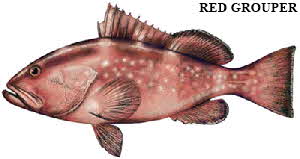GROUPERSee also: Grouper Recipes - Grouper Trivia - Ciguatera Poisoning
All groupers are members of the sea bass family, Serranidae, and are found in tropical and warm temperate waters worldwide. Black and red grouper are the most popular of these. Due to their preferred habitat around coral reefs, groupers are accessible primarily by hook-and-line fishing. Like all seafood in Florida, the harvesting of grouper is closely monitored and regulated to ensure healthy stocks as a naturally renewable and sustainable resource.
DESCRIPTIONRed groupers are members of the seabass family, Serranidae, and are found in tropical and warm temperate waters worldwide. The Serranidae has over 400 species which are found around coral reefs and rock outcroppings of the coastal shelf. Due to their preferred habitat, groupers and other family members are accessible by hook-and-line fishing and less vulnerable to trawl fishery. 
Two genera of groupers are caught throughout Florida: Mycteroperca and Epinephelus. They vary in size and weight, but are commonly marketed at 5-20 pounds. The large, white-flaked flesh contains no intramuscular bones. The skin is tough and strongly flavored and should be removed during cleaning.
Grouper has also become the choice of people concerned with healthy eating because it is nutritious in addition to being delicious. Four ounces of uncooked grouper has only 110 calories, 2 grams of fat (none of which is saturated) and only 55 grams of cholesterol. When you add the 23 grams of protein plus calcium and iron, grouper begins to look like the perfect food. Because the grouper meat is so low in fat, some basting may be necessary when grilling, broiling or baking. Florida grouper can be purchased fresh or frozen. Seasoned seafood chefs agree that grouper is one of the best “real Florida” seafood culinary choices. It can be used in almost any seafood recipe and its unique flavor comes out beautifully with a touch of mild seasoning and fresh herbs.
GROUPER ATTRIBUTESFirm texture, white meat with large flake and a mild flavor. Extra lean fish.
SUBSTITUTE SPECIESAmberjack, Snapper, Mahi-Mahi, Catfish, Tilefish, Shark.
HOW MUCH TO BUY• Whole or drawn fish: 3/4 to 1 pound per serving.
• Dressed or cleaned fish: 1/2 pound per serving.
• Fillets or steaks: 1/4 to 1/3 pound per serving.
BUYING, STORAGE AND HANDLINGRemember to purchase seafood last and keep it cold during the trip home. Fresh whole fish should have:
-- A shiny surface with tightly adhering scales.
-- Gills that are deep red or pink, free of slime, mucus and off-odor.
-- Clean shiny belly cavity with no cuts or protruding bones.
-- A mild aroma, similar to the ocean.
Fresh steaks, fillets and loins should have:
-- A translucent look.
-- Flesh that is firm and not separating.
-- A mild odor, similar to the ocean.
-- No discoloration.
-- Packaging that keeps them from being bent in an unnatural position.
PREPARATION• Keep raw and cooked seafood separate to prevent bacterial cross-contamination.
• After handling raw seafood thoroughly wash knives, cutting surfaces, sponges and your hands with hot soapy water.
• Always marinate seafood in the refrigerator.
• Discard marinade; it contains raw juices which may harbor bacteria.
• When marinade is needed for basting reserve a portion before adding raw seafood.
COOKING• Red Grouper lends itself well to any form of cooking. Because it is a lean fish, some basting is necessary while broiling or baking to keep the flesh moist. The heads are cartilaginous and produce a rich stock base.
• The general rule is 10 minutes per inch of thickness, at the thickest part of the fillet or steak, at 400-450 degrees F.
• If fish is cooked in parchment, foil or a sauce, add 5 minutes to the total cooking time.
• Fillets less than 1/2 inch thick do not need to be turned during cooking.
• Fish cooks quickly. Do not overcook.
• Fish is done when the flesh becomes opaque and flakes easily when tested with a fork.
• Poaching, steaming, baking, broiling, sautéing, microwaving are excellent low-fat cooking methods, if you do not add high fat ingredients.
• Marinate in your favorite salad dressing prior to cooking.
• Broil, bake, steam or microwave, then cube and add to pasta or salad greens for a delicious salad.
• Broil or grill with lime-butter and seasoned salt.
• Oil the grill to prevent fish from sticking.
• Bake whole fish with a crab or shrimp stuffing.
• Add leftover fish in broken pieces to salads, soups or sauces.
NUTRITIONNutritional values for approximately 4 ounces (114 grams) of raw, edible portions • Calories 110
• Calories From Fat 20
• Total Fat 2 g
• Saturated Fat 0 g
• Cholesterol 55 mg
• Sodium 65 mg
• Total Carbohydrates 0 g
• Protein 23 g
Florida Department of Agriculture and Consumer Services www.fl-seafood.com | 